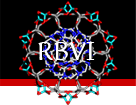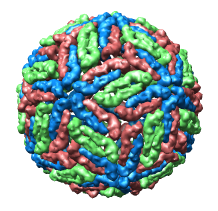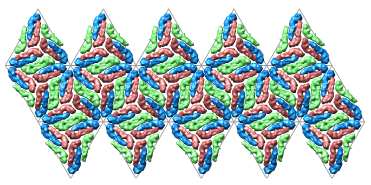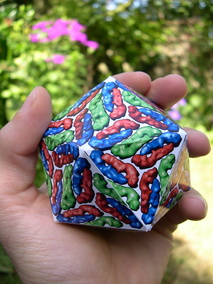

 home
overview
research
resources
outreach & training
outreach & training
visitors center
visitors center
search
search
home
overview
research
resources
outreach & training
outreach & training
visitors center
visitors center
search
search


 home
overview
research
resources
outreach & training
outreach & training
visitors center
visitors center
search
search
home
overview
research
resources
outreach & training
outreach & training
visitors center
visitors center
search
search

Paper Virus Models
Introduction
Physical 3-dimensional models have some advantages over computer graphics. They can be effective for explaining structures to small groups because the use of hands and fingers to point and illustrate motions, assembly, and dynamic features is very powerful.Product
Using a printer, scissors and tape it is easy to construct icosahedral virus models that show the arrangment of proteins in the virus capsid. The Chimera Flatten Icosahedron creates the printed layout suitable for printing, cutting and folding.



Dengue virus 1k4r Flattened Paper model Evaluation
We've made about a dozen different models from data obtained from the VIPERdb web site. Many were made by kids aged 9 - 11 at UCSF Kid's Day. We have also packed inside the paper models strips of paper (3 to 5 meters long by 1 cm wide) with the RNA viral genome sequence (5000 - 20000 bases) shown as color bars that give a sense of scale to viral genomes. Image files for making 12 virus models are available.
Here is a 5 inch by 10 inch, 300 dpi flattened dengue virus image suitable for printing. The model picture above was made in about 30 minutes by printing this image on photo paper, cutting, folding and taping.
Results
Paper virus models are an effective teaching tool. The Protein Data Bank has created an exercise for high school students on virus shape and structure constructing a paper model of polio virus.
Laboratory Overview | Research | Outreach & Training | Available Resources | Visitors Center | Search